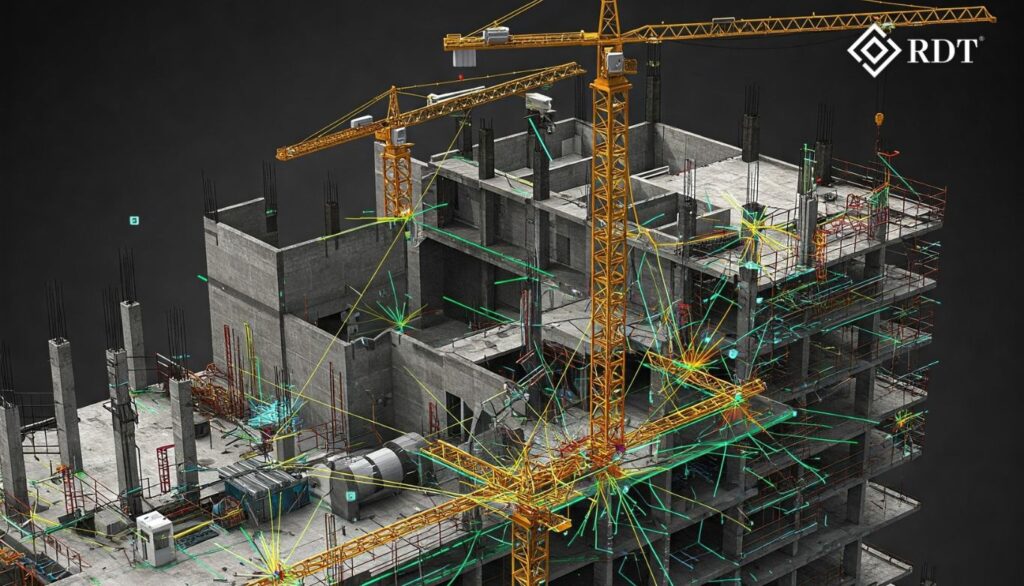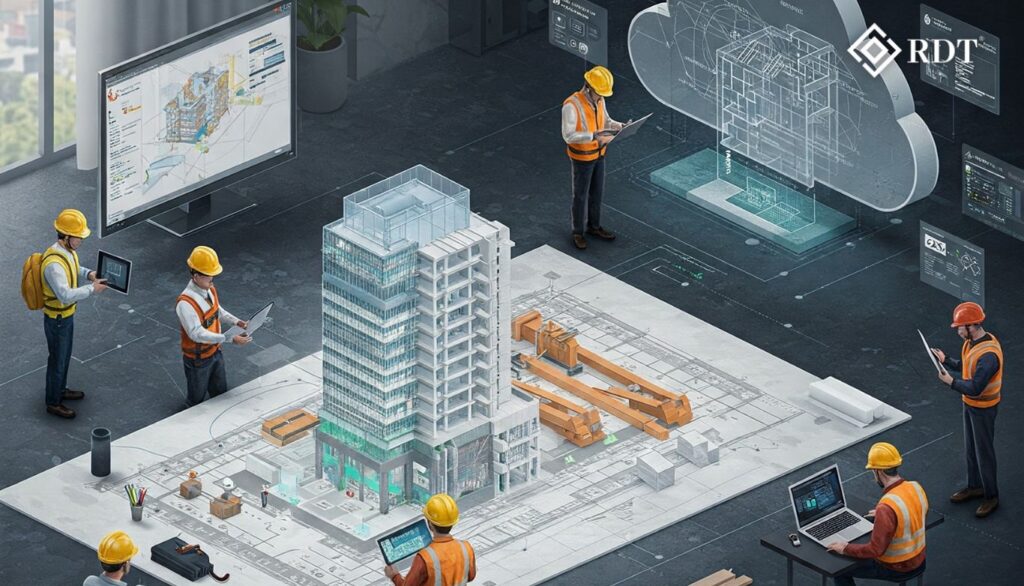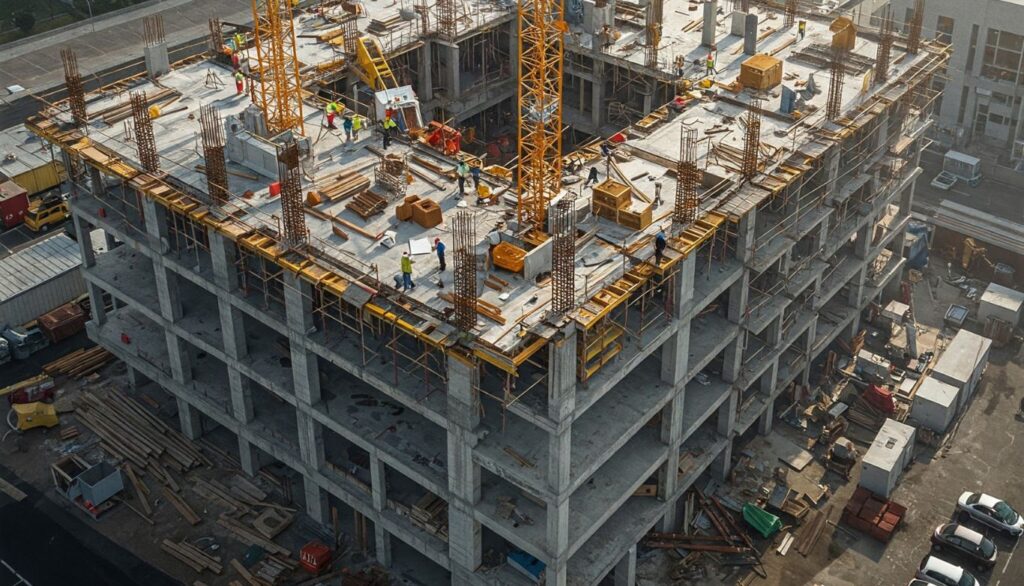For enterprise-level architects, VDC managers, and BIM professionals, the complexity of modern construction demands advanced technological solutions. Efficient clash detection and coordination have evolved from simple model overlays to sophisticated, AI-powered, and predictive systems. These ensure seamless multi-trade collaboration, prevent costly errors, and accelerate project timelines.
In this technical guide, we’ll explore the next-generation clash detection methodologies, integrating 5D BIM, AI-based algorithms, digital twins, and cloud collaboration platforms. Implementing these solutions significantly enhances constructability and operational efficiency.
1. The Evolution of Clash Detection: From 3D Model Overlays to Predictive Coordination
Traditional clash detection involved manually comparing 2D drawings or relying on 3D model overlays. While tools like Navisworks and Solibri remain essential, industry leaders are advancing toward AI-powered detection with predictive capabilities.
Federated Model Generation
- Multi-Discipline Integration: Structural, MEP, and architectural models are merged into a centralized federated BIM. Tools like Revit, Tekla Structures, and AutoCAD Plant 3D offer seamless interoperability through IFC (Industry Foundation Classes) or BCF (BIM Collaboration Format) files.
- AI-Enhanced Model Validation: AI algorithms automatically detect geometric clashes, clearance issues, and code violations using historical clash data.
Multi-Layered Clash Hierarchies
- Hard Clashes: Direct physical interferences like overlapping ductwork and beams.
- Soft Clashes: Violations of proximity clearances, typically found in MEP systems.
- Workflow Clashes: Sequence-based conflicts where construction activities interfere.
Using AI-driven clash detection algorithms, contractors resolve conflicts before construction mobilization, preventing RFIs and delays.
2. Predictive Clash Detection Using AI and Machine Learning

Modern systems employ AI and machine learning (ML) algorithms to forecast potential clashes based on past project data. Unlike static clash detection, predictive systems assess design intent, material properties, and construction sequences.
AI Training Models for Clash Prediction
- Historical Data Analysis: AI models are trained using large datasets of resolved clashes across similar project types.
- Object Recognition Algorithms: AI detects proprietary components using classification models to predict clash likelihoods.
- Contextual Decision-Making: Machine learning factors in environmental conditions, load-bearing scenarios, and spatial tolerances.
Advanced Scenario Simulations
- Monte Carlo Simulations: Thousands of design iterations are tested under different conditions to predict clash probabilities.
- Time-Phased Clash Detection: AI algorithms evaluate models at various construction phases using 4D BIM data, detecting time-specific clashes.
Through machine learning-enhanced clash detection, enterprise architects gain real-time insights into potential errors before they occur.
3. Multi-Disciplinary Model Coordination and Real-Time Collaboration

Successful clash resolution requires advanced multi-disciplinary coordination. Real-time collaboration platforms integrated with Digital Twins and cloud-based BIM systems ensure that all project stakeholders work with synchronized data.
Federated Model Management
- Platforms like BIM 360 Coordinate and Trimble Connect allow federated models to be shared across all disciplines.
- Continuous Model Synchronization: Cloud-connected environments provide real-time model updates, avoiding version conflicts.
Automated Issue Tracking and Resolution
- Clash Tracking Dashboards: Tools like BIM Track provide dynamic dashboards that log clashes, track resolutions, and assign tasks to responsible teams.
- Automated Rule-Set Generation: AI creates customized rule sets for different systems, improving clash identification accuracy.
- Conflict Resolution Proposals: AI suggests alternative routing, load distribution, or material changes to resolve detected clashes.
Using real-time collaboration and Digital Twin platforms, architects and contractors mitigate coordination failures.
4. Parametric Clash Avoidance and Constraint-Based Design
Rather than relying on post-modeling detection, architects can employ parametric modeling and constraint-based design to proactively avoid clashes.
Algorithmic Design Systems
- Generative Design Algorithms: Tools like Grasshopper and Dynamo generate clash-free design alternatives by following specified geometric and performance constraints.
- AI-Powered Design Validation: AI systems analyze clash-prone zones and recommend geometric modifications.
Constraint-Based Coordination
- Topology Optimization Algorithms: Structural components are designed using topology optimization to minimize material use and avoid clashes.
- MEP Routing Algorithms: AI generates optimized ductwork, piping, and electrical pathways using dynamic routing algorithms.
By integrating parametric design modules, architects eliminate design-stage clashes, reducing rework costs.
5. Enhanced 4D and 5D BIM for Clash Detection in Construction Sequences

Time-based conflicts are often overlooked during traditional clash detection. Implementing 4D BIM (time) and 5D BIM (cost) provides critical insights into spatial conflicts during various construction phases.
Construction Phasing Simulations
- 4D Scheduling Integration: Platforms like Synchro 4D simulate time-based clashes caused by crane placement, material staging, or simultaneous trades.
- Sequence Optimization: AI-driven simulations recommend optimal construction sequences to minimize spatial interference.
Cost Impact Analysis with 5D BIM
- Cost-Aware Clash Resolution: Integrated 5D models analyze the financial impact of clashes and suggest cost-effective solutions.
- Resource Reallocation Algorithms: AI predicts material wastage from unresolved clashes and recommends alternative procurement strategies.
Using 4D and 5D BIM modules, construction managers reduce project delays and unexpected costs.
6. Clash Detection in Prefabrication and Modular Construction
Offsite prefabrication and modular construction require even higher clash detection accuracy. Components manufactured offsite must meet precise tolerances to ensure seamless onsite assembly.
AI-Guided Fabrication Validation
- Tolerance-Driven Clash Detection: AI validates model components against fabrication tolerances to detect fitment clashes.
- Digital Twin Integration: Sensors embedded in prefab modules provide real-time data on alignment deviations.
Robotic Clash Resolution
- Laser Scanning and Point Cloud Comparison: LiDAR scans generate point clouds, which AI compares to BIM models for alignment verification.
- Automated Robotic Adjustments: AI-powered robotic systems adjust components based on detected misalignments.
Using prefabrication clash detection algorithms, contractors ensure faultless onsite assembly, reducing rework costs.
Conclusion
Effective clash detection is no longer a reactive process. Advanced AI algorithms, parametric design systems, 4D/5D BIM, and Digital Twins empower architects to predict, prevent, and resolve clashes before construction begins.
With cutting-edge BIM solutions, enterprise-level stakeholders can mitigate risks, optimize timelines, and ensure seamless project delivery.





